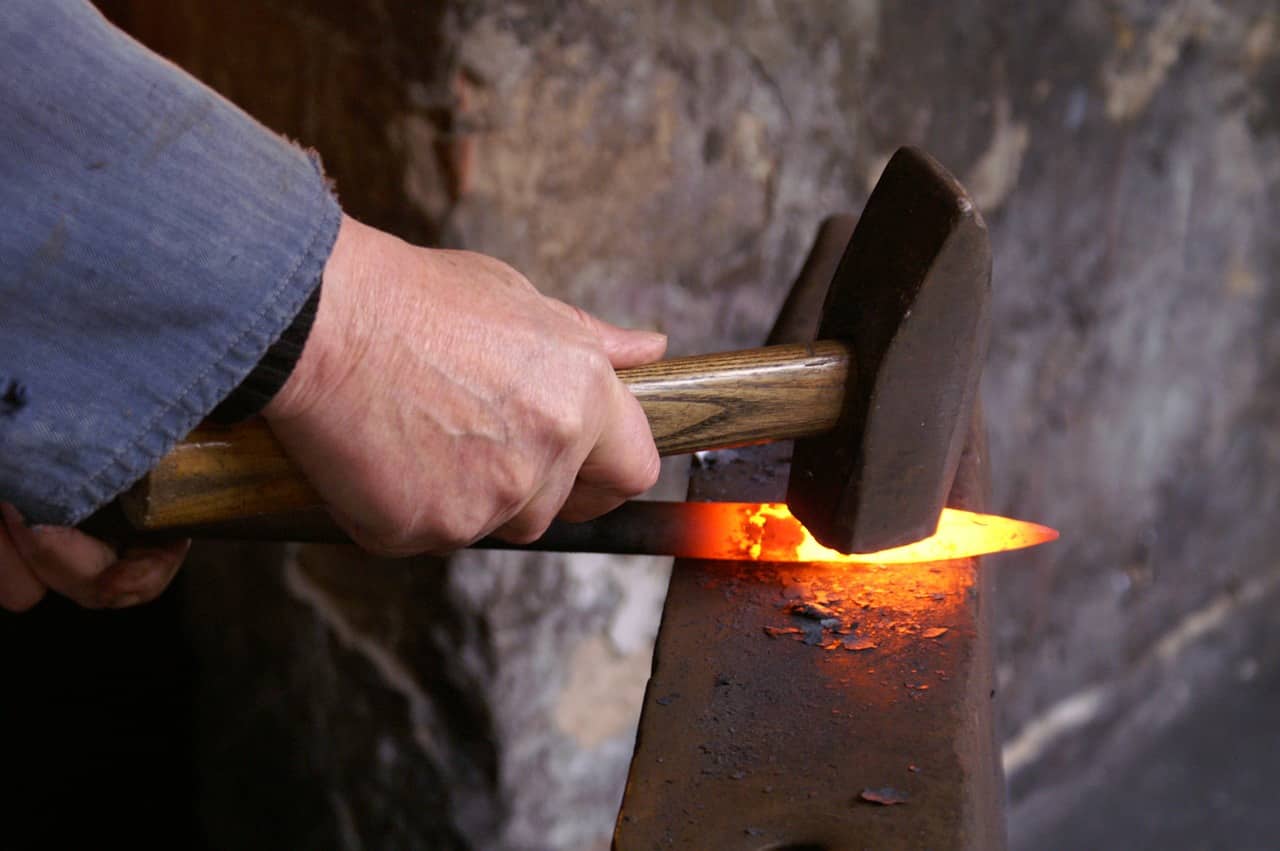
Blacksmithing is a fascinating craft that has been around for centuries, dating back to ancient civilizations. It is an art form that involves heating, shaping, and forging metal into useful objects and works of art. The process of blacksmithing requires skill, precision, and creativity, making it a truly extraordinary profession.
In this article, we will explore 19 extraordinary facts about blacksmithing that will give you a deeper insight into this ancient trade. From historical anecdotes to modern-day applications, we will delve into the world of blacksmithing and uncover some unique and surprising aspects of the craft.
So, whether you have a keen interest in metalworking or are simply curious about the art of blacksmithing, sit back, relax, and prepare to be amazed by the fascinating world of blacksmithing!
Key Takeaways:
- Blacksmithing is an ancient craft passed down through generations, creating both functional tools and stunning works of art with the rhythmic clang of metal hitting metal.
- Modern blacksmiths are preserving traditions while pushing boundaries, inspiring creativity and continuing the demand for handcrafted, high-quality, and unique pieces.
Ancient Origins
Blacksmithing is an ancient craft that dates back thousands of years. It emerged during the Bronze Age and has remained an essential trade ever since.
Forging Fire
The heart of blacksmithing lies in the forging process. It involves heating metal to a high temperature and then shaping it through hammering and other techniques.
Skills Passed Down
Blacksmithing is often a trade that is passed down through generations. Many modern-day blacksmiths learned their craft from their parents or grandparents.
Adaptable Artistry
Blacksmithing is a versatile craft that allows for the creation of both functional and decorative pieces. From tools and weapons to intricate ironwork, the possibilities are endless.
Heat and Hammers
Blacksmiths rely on intense heat and heavy hammers to shape metal. This requires strength, precision, and a deep understanding of the properties of different metals.
Creating Beauty
Blacksmiths have the ability to transform ordinary pieces of metal into stunning works of art. They can skillfully shape intricate designs and patterns with incredible detail.
The Sound of Success
The rhythmic clang of metal hitting metal is synonymous with blacksmithing. It is a sound that signifies the transformation of raw materials into a finished product.
Historical Significance
Blacksmithing played a crucial role in the development of civilizations throughout history. It provided tools and weapons that were essential for survival.
Preservation of Traditions
Despite advancements in technology, blacksmithing remains a time-honored tradition. Many artisans continue to practice this craft, ensuring that the skills and techniques are preserved for future generations.
Metalworking Mastery
Blacksmiths possess extensive knowledge of various metals, including their properties, strengths, and limitations. This expertise allows them to choose the right material for each project.
Affinity for Fire
Blacksmiths have a unique relationship with fire. They rely on the intense heat of the forge to shape and mold metal, harnessing the power of fire as a tool.
The Art of Patience
Blacksmithing requires patience and precision. It can be a slow and meticulous process, as each piece is carefully crafted by hand.
Traveling Blacksmiths
In ancient times, some blacksmiths were nomadic, traveling from village to village to provide their services. They carried their tools and portable forges with them.
Global Influence
Blacksmithing is a craft that has been practiced in various forms across different cultures around the world. Each culture has its own unique techniques and designs.
Community Connection
Blacksmiths often play an important role in their communities. They create custom pieces for individuals and businesses and contribute to local infrastructure projects.
Forging New Paths
Modern blacksmiths are pushing the boundaries of traditional blacksmithing techniques. They experiment with new materials, styles, and methods to create innovative and contemporary pieces.
Preserving History
Blacksmithing is not just about creating new pieces; it is also about preserving historical artifacts. Blacksmiths often engage in restoration projects to bring old pieces back to their former glory.
Continued Craftsmanship
Despite advancements in technology, there is still a demand for handcrafted blacksmithing. People appreciate the uniqueness and quality of handmade items.
Inspiring Creativity
Blacksmithing can be a source of inspiration for other artistic endeavors. Many artists and craftsmen draw inspiration from the techniques and designs used in blacksmithing.
Conclusion
In conclusion, blacksmithing is a fascinating craft that has a rich history dating back centuries. It combines artistry, skill, and physical strength to create beautiful and functional metal objects. From swords and armor to intricate decorative pieces, blacksmiths have played a vital role in shaping our world.Today, blacksmithing continues to thrive as a beloved hobby and a respected profession. It offers a unique blend of traditional techniques and modern innovations, allowing artisans to create extraordinary pieces that capture the imagination. Whether you’re a blacksmith yourself or simply curious about this ancient craft, exploring the world of blacksmithing is sure to inspire and captivate you.So, dive into the world of blacksmithing and discover the beauty and craftsmanship that goes into every hammer strike, bend, and twist of metal. Experience the satisfaction of creating something with your own hands and gain a deeper appreciation for the artistry and skill that blacksmiths possess. Ready to forge your own path? Let the sparks fly and unleash your creativity in the world of blacksmithing.
FAQs
Q: How long does it take to become a skilled blacksmith?
A: Becoming a skilled blacksmith takes time and practice. It can range from a few months to several years, depending on the level of dedication and frequency of practice.
Q: What kind of tools do you need to start blacksmithing?
A: Some essential tools for blacksmithing include a forge, an anvil, a hammer, tongs, chisels, and a grinder. These tools are fundamental in shaping and manipulating the metal.
Q: Is blacksmithing dangerous?
A: Blacksmithing involves working with hot metals and heavy equipment, so there are inherent risks involved. However, with proper training, safety precautions, and protective gear, the risks can be minimized.
Q: Can anyone learn blacksmithing?
A: While blacksmithing requires physical strength and stamina, anyone with the determination and willingness to learn can become a blacksmith. It is a skill that can be acquired with practice and guidance.
Q: What can I create as a beginner blacksmith?
A: As a beginner blacksmith, you can start by creating simple items like hooks, nails, and small decorative pieces. These projects will help you build basic skills and gain confidence in your abilities.
Q: Are there any traditional blacksmithing techniques still used today?
A: Yes, many traditional blacksmithing techniques are still used today, such as forge welding, riveting, and hot and cold shaping. These techniques have stood the test of time and continue to be an integral part of the craft.
Q: Can blacksmithing be a profitable business?
A: Yes, blacksmithing can be a profitable business. Many blacksmiths sell their creations at craft fairs, art galleries, and online platforms. Additionally, some blacksmiths take on custom orders or offer classes to generate income.
Q: Are there any famous blacksmiths in history?
A: Yes, there have been many famous blacksmiths throughout history, including Leonardo da Vinci, H?nen, and Francis Whitaker. These individuals have made significant contributions to the art of blacksmithing and left a lasting legacy.
Blacksmithing's rich history and enduring legacy continue to captivate enthusiasts worldwide. Delving deeper into this ancient craft reveals even more astonishing facts that showcase blacksmiths' incredible skills and the vital role they've played in shaping civilizations. From the mesmerizing properties of molten metal to the iconic anvil's central role in a blacksmith's workshop, there's always more to explore in this fascinating world. So, if you're eager to expand your knowledge and appreciate the artistry behind blacksmithing, keep reading to uncover more extraordinary facts that will leave you in awe of this timeless profession.
Was this page helpful?
Our commitment to delivering trustworthy and engaging content is at the heart of what we do. Each fact on our site is contributed by real users like you, bringing a wealth of diverse insights and information. To ensure the highest standards of accuracy and reliability, our dedicated editors meticulously review each submission. This process guarantees that the facts we share are not only fascinating but also credible. Trust in our commitment to quality and authenticity as you explore and learn with us.


